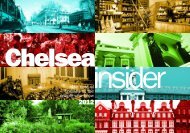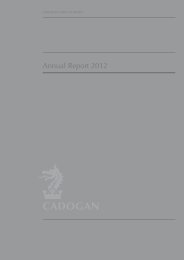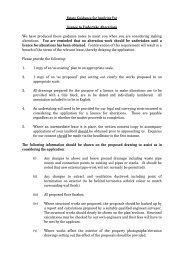The best of Chelsea by the people who know - Cadogan
The best of Chelsea by the people who know - Cadogan
The best of Chelsea by the people who know - Cadogan
Create successful ePaper yourself
Turn your PDF publications into a flip-book with our unique Google optimized e-Paper software.
19 | STREETS & SIGHTS |<br />
impressive statue <strong>of</strong> Charles II, which<br />
was regilded in 2002 for <strong>the</strong> Queen’s<br />
Golden Jubilee.<br />
<strong>The</strong> <strong>Chelsea</strong> Pensioners <strong>the</strong>mselves<br />
are immediately recognisable in <strong>the</strong>ir<br />
scarlet uniforms, and <strong>the</strong>re are tours <strong>by</strong><br />
<strong>Chelsea</strong> Pensioner guides (see<br />
Museums). <strong>The</strong> RHS <strong>Chelsea</strong> Flower<br />
Show has been held in <strong>the</strong> South<br />
Grounds <strong>of</strong> <strong>the</strong> hospital since 1913.<br />
<strong>The</strong>re are events, such as concerts, held<br />
at <strong>the</strong> hospital and certain rooms can be<br />
hired for functions or weddings.<br />
<strong>The</strong> Royal Hospital was established<br />
under Charles II, <strong>who</strong> issued a Royal<br />
Warrant in 1681 authorising its building<br />
to provide for <strong>the</strong> welfare <strong>of</strong> old or disabled<br />
soldiers. Sir Christopher Wren,<br />
Surveyor-General <strong>of</strong> Works to Charles II,<br />
was commissioned to design it and Sir<br />
Stephen Fox, former Paymaster General<br />
to <strong>the</strong> Army and Commissioner <strong>of</strong> <strong>the</strong><br />
Treasury, secured <strong>the</strong> funds – with some<br />
difficulty.<br />
Despite delays and problems with<br />
funding, building work was finally<br />
completed in 1692 and in February <strong>the</strong><br />
same year, <strong>the</strong> first in-pensioners were<br />
admitted. <strong>The</strong> hospital includes <strong>the</strong> Long<br />
Wards, which contains <strong>the</strong> pensioners’<br />
living quarters, <strong>the</strong> State Apartments, <strong>the</strong><br />
Wren Chapel, <strong>the</strong> Great Hall and <strong>the</strong><br />
Octagon. <strong>The</strong> berths in <strong>the</strong> Long Wards,<br />
where <strong>the</strong> pensioners sleep, were<br />
extended in 1954-55 and again in 1991<br />
to <strong>the</strong>ir present size <strong>of</strong> 9 x 9ft.<br />
<strong>The</strong> Royal Hospital was funded <strong>by</strong><br />
deductions from army pay and got occasional<br />
boosts from o<strong>the</strong>r sources in its<br />
early days, but since 1847 it has been<br />
supported <strong>by</strong> Government ‘grant-in-aid’,<br />
legacies, donations and unclaimed shares<br />
<strong>of</strong> money from <strong>the</strong> Army Prize Fund.<br />
Today it is still supported <strong>by</strong> grant-in-aid<br />
but major projects and non-routine maintenance<br />
are funded <strong>by</strong> private donations.<br />
It is home to between 300 and 350<br />
veteran soldiers <strong>who</strong> have surrendered<br />
<strong>the</strong>ir military pension to <strong>the</strong> Treasury in<br />
return for accommodation, food, uniform<br />
clothing and medical care.<br />
<strong>The</strong> Great Hall, where <strong>the</strong> pensioners<br />
eat, is an impressive space and features<br />
a number <strong>of</strong> artworks, including a mural<br />
painting <strong>by</strong> Antonio Verrio and Henry<br />
Cooke <strong>of</strong> Charles II on horseback, dating<br />
from around 1690, which was restored<br />
in 2002.<br />
One <strong>of</strong> <strong>the</strong> hospital’s real gems is <strong>the</strong><br />
Wren Chapel. It has a high ceiling, great<br />
acoustics and a mural <strong>of</strong> <strong>the</strong><br />
Resurrection <strong>by</strong> Sebastiano Ricci, dating<br />
from 1714. <strong>The</strong> first televised church<br />
service in Britain was broadcast from <strong>the</strong><br />
chapel in 1949.<br />
<strong>Chelsea</strong> pensioner tour guides<br />
<strong>The</strong> Octagon, which links <strong>the</strong> chapel<br />
and <strong>the</strong> Great Hall, supports <strong>the</strong> cupola<br />
and rises to 130ft. <strong>The</strong> Royal Coat <strong>of</strong><br />
Arms over <strong>the</strong> north entrance originally<br />
came from <strong>the</strong> Royal Hospital at<br />
Kilmainham, Dublin, which closed in<br />
1925. <strong>The</strong> striking statue <strong>of</strong> a <strong>Chelsea</strong><br />
Pensioner <strong>by</strong> Philip Jackson was erected<br />
in front <strong>of</strong> <strong>the</strong> Octagon in 2000 to mark<br />
<strong>the</strong> new millennium.<br />
Sir John Soane added a new infirmary<br />
building on <strong>the</strong> site <strong>of</strong> today’s National<br />
Army Museum in 1809, but it was<br />
demolished after being bombed in 1941,<br />
Royal Borough <strong>of</strong> Kensingon & <strong>Chelsea</strong>, Family & Children’s Service<br />
St Luke’s and<br />
Christ Church<br />
St Luke’s Church<br />
St Luke’s on Sydney Street and Christ Church<br />
<strong>of</strong>f Flood Street are treated as <strong>the</strong> same parish.<br />
St Luke’s, designed <strong>by</strong> James Savage, was<br />
consecrated in 1824 and was built because<br />
<strong>Chelsea</strong> Old Church had become too small for<br />
<strong>the</strong> rising population. Christ Church, designed<br />
<strong>by</strong> Edward Blore, was consecrated in 1839,<br />
originally as a ‘chapel <strong>of</strong> ease’ for St Luke’s.<br />
St Luke’s is regarded as one <strong>of</strong> <strong>the</strong> first<br />
neo-Gothic churches in London.<br />
Charles Dickens married Ca<strong>the</strong>rine Hogarth<br />
at St Luke’s on April 2, 1836, two days after<br />
<strong>the</strong> first part <strong>of</strong> <strong>The</strong> Pickwick Papers was published.<br />
O<strong>the</strong>r famous figures connected with<br />
<strong>the</strong> church include <strong>The</strong> Water-Babies author<br />
Charles Kingsley, <strong>who</strong>se fa<strong>the</strong>r was <strong>the</strong> rector<br />
<strong>of</strong> <strong>the</strong> parish from 1836-1860; John Goss,<br />
<strong>who</strong> wrote <strong>the</strong> hymn Praise My Soul <strong>the</strong> King<br />
<strong>of</strong> Heaven; and John Ireland, <strong>who</strong> wrote <strong>the</strong><br />
tune for My Song is Love Un<strong>know</strong>n. Goss and<br />
Ireland were organists at <strong>the</strong> church.<br />
<strong>The</strong> nave is 60ft high, thought to be <strong>the</strong><br />
tallest <strong>of</strong> any parish church in London, and <strong>the</strong><br />
tower is 142ft tall. <strong>The</strong> east window covers<br />
more than 500 sq ft and was designed <strong>by</strong><br />
Hugh Easton. It features emblems <strong>of</strong> <strong>the</strong><br />
saints and was installed in 1959 to replace a<br />
window destroyed in <strong>the</strong> Second World War.<br />
Behind <strong>the</strong> altar, a painting <strong>by</strong> James<br />
Northcote (1746-1831) shows <strong>the</strong> taking <strong>of</strong><br />
Christ from <strong>the</strong> cross, and two modern sculptures<br />
<strong>by</strong> Stephen Cox ei<strong>the</strong>r side <strong>of</strong> <strong>the</strong> high<br />
altar depict Adam and Eve at <strong>the</strong> fall <strong>of</strong> man<br />
in <strong>the</strong> Garden <strong>of</strong> Eden. <strong>The</strong> ten bells in <strong>the</strong><br />
tower were cast at Whitechapel when <strong>the</strong><br />
church was built and are still rung.<br />
<strong>The</strong> organ at St Luke’s was built <strong>by</strong> John<br />
Compton in 1932 and includes some <strong>of</strong> <strong>the</strong><br />
original 1824 instrument. It was <strong>the</strong> prototype<br />
for <strong>the</strong> organs at Broadcasting House and<br />
Downside Abbey.<br />
<strong>The</strong> PPFA Chapel on <strong>the</strong> south side <strong>of</strong> <strong>the</strong><br />
church is used for prayer and is a memorial<br />
chapel to <strong>the</strong> Punjab Frontier Force, based in<br />
India from 1847 to 1947. <strong>The</strong>re are o<strong>the</strong>r<br />
memorials to locals at St Luke’s, including Lt<br />
Col Henry <strong>Cadogan</strong> and Luke Thomas Flood.<br />
<strong>The</strong> la<strong>by</strong>rinth <strong>of</strong> crypts under <strong>the</strong> church is<br />
now used as <strong>of</strong>fices, and <strong>the</strong> burial ground<br />
has been a public garden since 1881 (see<br />
Green Spaces).<br />
Christ Church is smaller than St Luke’s and<br />
was designed as a church for <strong>the</strong> working<br />
class. It was funded <strong>by</strong> <strong>the</strong> Hydman family<br />
trust and cost much less than St Luke’s, <strong>the</strong><br />
idea being to cater for <strong>the</strong> maximum number<br />
<strong>of</strong> <strong>people</strong> for <strong>the</strong> minimum cost. It was<br />
extended over <strong>the</strong> years, with adornments<br />
added as <strong>the</strong> social make-up <strong>of</strong> <strong>the</strong> area<br />
changed. <strong>The</strong> organ and pulpit were rescued<br />
from churches that were being demolished.<br />
Christ Church established a boys’ school<br />
soon after its consecration at rented property<br />
in Flood Street. It accepted girls from 1843,<br />
when land was donated <strong>by</strong> Lord <strong>Cadogan</strong><br />
and new schools were built. Today, it is a<br />
Church <strong>of</strong> England primary school.<br />
Christ Church rejoined St Luke’s in 1986 to<br />
form <strong>the</strong> Parish <strong>of</strong> <strong>Chelsea</strong>: St Luke and<br />
Christ Church. Each church is managed<br />
separately.<br />
For more information, telephone 020 7351<br />
7365 or visit www.chelseaparish.org.







